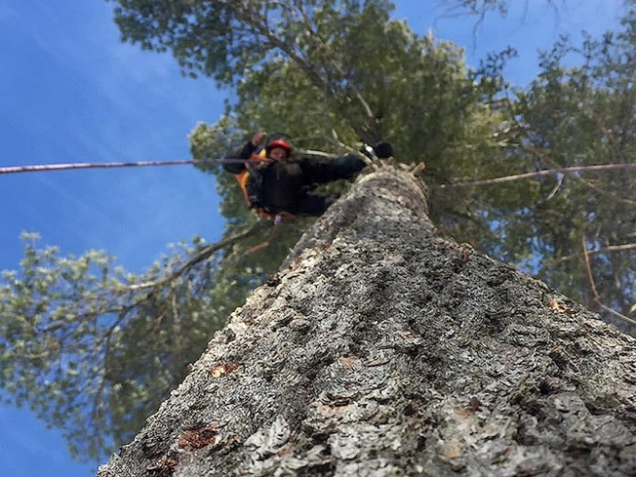Differences Between Pruning and Trimming
There are a lot of people who believe that tree pruning and tree trimming are the same things. They are similar, but there are some notable differences to remember. It can be helpful to look at a table that compares the differences between tree pruning and tree trimming. Some of the most essential points to keep in mind include:
| Tree Pruning | Tree Trimming |
|---|---|
| Tree pruning is typically used to remove unnecessary branches | Tree trimming is to promote healthy growth of your branches and leaves |
| Tree pruning is typically done using hand shears or topping shears | Tree trimming uses shears, saws, and trimmers |
| Tree pruning is typically done once per year. Dormant trees are typically pruned during the winter to ensure they grow well during the spring. | Tree trimming usually occurs twice per year, with one appointment just after the flowers begin to bloom. |
Trimming
Regular tree trimming is not just a task but a proactive measure that helps us prevent potential hazards. Overgrown branches can fall during storms, causing property damage or injury. By understanding the importance of trimming these branches, we empower ourselves to mitigate risks associated with falling limbs, ensuring the safety and well-being of our property and its inhabitants.
Hanging branches near power lines pose a significant safety concern. We can address these issues, reducing the risk of electrical fires or power outages. Dead or weakened branches are likelier to break off, especially during windy or icy conditions. By removing them, we ensure that the trees on our property pose fewer dangers to people and surroundings.
By removing dead or diseased branches, we prevent the spread of disease and decay to other parts of the tree, allowing the tree to focus its resources on healthy growth. Trimming also fosters better air circulation and sunlight penetration, vital for a tree’s photosynthesis. Increased airflow reduces the likelihood of fungal infections, while sunlight helps maintain a robust tree structure.
Well-maintained trees significantly enhance the visual appeal of our properties. Proper trimming helps shape the trees, maintaining their natural beauty and ensuring they complement our landscape design. This not only increases property values but also enhances the overall aesthetic of our property, giving us a sense of pride and satisfaction in our investment.
Pruning
At the core of this intricate service lies a series of strategic steps, starting with a detailed assessment of pruning needs that pinpoints the precise care each tree demands. With a deep understanding of tree biology and specialized techniques, our arborists precisely execute pruning, ensuring that each cut contributes to the tree’s robust structure and disease resistance.
Timing is not just a factor but a crucial element in the pruning process. Specific seasons are identified as optimal for pruning, as they encourage healing and growth, thereby significantly impacting the tree’s health.
After the meticulous pruning process, the property owners are responsible for sustaining the trees’ vitality and majesty. They are guided by a regimen of post-pruning care and maintenance tips, which they must follow diligently.
Assessing Your Trees for Pruning Needs
The initial step in the professional limb pruning process involves thoroughly assessing the trees’ pruning needs, an undertaking crucial for tailoring the care to each tree’s specific requirements. Certified arborists conduct visual inspections to identify dead, diseased, or weak branches that might compromise the tree’s health or pose a safety hazard.
Determining the correct timing and extent of pruning is another integral part of the assessment, as these factors significantly influence the tree’s ability to heal and grow. This careful evaluation ensures that pruning activities support the tree’s overall vitality, structure, and aesthetic appeal, laying the groundwork for a successful pruning outcome.

Techniques Used by Eagle Tree for Effective Pruning
Our arborists employ a variety of sophisticated techniques for effective pruning. One fundamental method involves selective thinning, which enhances air circulation and light penetration throughout the canopy, fostering a healthier tree structure. This precise technique, managed by one of our certified arborists, improves the tree’s overall health and reduces the risk of disease.
Another crucial technique is crown cleaning, meticulously removing dead, diseased, or broken branches from the tree. This practice not only safeguards the property and its inhabitants by preventing potential hazards but also contributes significantly to the aesthetic beauty of the tree. Crown cleaning underscores the meticulous attention to detail that certified arborists dedicate to each phase of the pruning process, ensuring that every action contributes to the tree’s longevity and visual appeal.
| Technique | Purpose | Benefit |
|---|---|---|
| Selective Thinning | Improve air circulation and light penetration | Healthier tree structure and reduced disease risk |
| Crown Reduction | Decrease the height or spread of the tree | Maintains tree stability and encourages growth |
| Deadwooding | Remove dead, diseased, or broken branches | Enhances safety and tree appearance |
When Is the Best Time for Pruning?
Generally, the best time for pruning most deciduous trees is during their dormant season, typically in late winter or early spring before new growth starts. This timing allows trees to heal rapidly from cuts and use the growing season to establish new growth.
However, certain situations, such as removing dead or dangerous branches, may necessitate immediate action regardless of the season. Additionally, the pruning of flowering trees may be best performed immediately after their blooming period to avoid cutting off buds that will bloom the following year. Understanding and adhering to these timing nuances is a hallmark of professional tree care services, ensuring trees maintain their health and aesthetic appeal year-round.
Why Use Eagle Tree?
Our professionals have the experience needed to handle the job. With years of trimming and pruning trees, they have mastered the art of it. Contact one of our expertly trained and skilled arborists today to book an assessment.